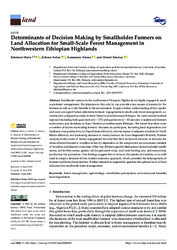| dc.contributor.author | Solomon, Mulu | |
| dc.contributor.author | Asfaw, Zebene | |
| dc.contributor.author | Alemu, Asmamaw | |
| dc.contributor.author | Demel, Teketay | |
| dc.date.accessioned | 2023-05-05T10:36:41Z | |
| dc.date.available | 2023-05-05T10:36:41Z | |
| dc.date.issued | 2022-06-03 | |
| dc.identifier.citation | Mulu, S., Asfaw, Z., Alemu, A., & Teketay, D. (2022). Determinants of Decision Making by Smallholder Farmers on Land Allocation for Small-Scale Forest Management in Northwestern Ethiopian Highlands. Land, 11(6), 838. | en_US |
| dc.identifier.issn | 2073-445X | |
| dc.identifier.uri | https://www.mdpi.com/journal/land | |
| dc.identifier.uri | https://doaj.org/toc/2073-445X | |
| dc.identifier.uri | https://doi.org/10.3390/land11060838 | |
| dc.identifier.uri | https://hdl.handle.net/13049/692 | |
| dc.description | CC BY 4.0 licence | en_US |
| dc.description.abstract | Smallholder farmers in the northwestern Ethiopian Highlands are highly engaged in small-scale forest management. Participation in this activity can provide a key source of income for the farmers as well as wider benefits to the environment. To gain a better understanding of how spatial and socio-ecological factors determine farmers’ engagements in small-scale forest management, we conducted a comparative study in three Districts of northwestern Ethiopia. We used a mixed method approach including both quantitative (n = 375) and qualitative (n = 45) surveys to understand farmers’ motivations and decisions in three Districts of northwestern Ethiopia. We found that there were a number of factors motivating farmers’ decisions to participate, including land degradation and decline in crop productivity (in Fagta Lekoma District); adverse impact of adjacent woodlots (in North Mecha District); and increasing demand of wood products (in Guna Begemidir District). Further analysis on the extent of farmer engagement revealed that their decision to increase or decrease the share of land allocated to woodlots is heavily dependent on the comparative socio-economic benefits of woodlots and distance to markets. Other key (District-specific) determinant factors included wealth status, soil fertility status, gender, adult equivalent value, total land holding size, and annual crop production risk perception. Our findings suggest that to increase the uptake of woodlots, we would need to adopt a demand-driven forestry extension approach, which considers the heterogeneity of farmers and farm characteristics. Further research is required to quantify the optimal level of land allocation for small-scale forest management. | en_US |
| dc.language.iso | en | en_US |
| dc.publisher | MDPI | en_US |
| dc.relation.ispartofseries | Land;11(6), 838 | |
| dc.subject | Agro-ecology | en_US |
| dc.subject | Forest management | en_US |
| dc.subject | Land degradation | en_US |
| dc.subject | Smallholder perceptions | en_US |
| dc.subject | Socio-economic benefits | en_US |
| dc.title | Determinants of Decision Making by Smallholder Farmers on Land Allocation for Small-Scale Forest Management in Northwestern Ethiopian Highlands. | en_US |
| dc.type | Article | en_US |

